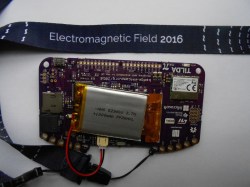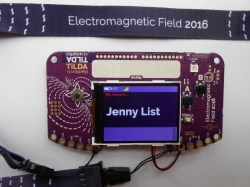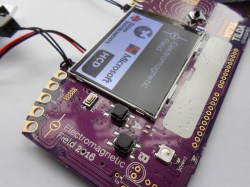The Scottish Consulate has stamped its last passport, the Dutch fire tower has belched its final flame, and the Gold Members Lounge has followed the Hacienda and the Marquee into clubland oblivion. EMF Camp 2016 is over, so all the 1500 or so attendees have left are the memories, photographs, and festival diarrhoea to remind them of their three days in the Surrey countryside.
Well, not quite all, there is the small matter of the badge.
In the case of EMF 2016 it was called TiLDA MKπ, and since there was a point earlier in the year when it seemed the badge might never see the light of day it represents a significant achievement from the EMF badge team.
The badge features an STM32L486VGT6 ARM Cortex M4 running at 80MHz, a 320×240 pixel colour LCD, magnetometer and accelerometer, and a CC3100 WiFi processor. The firmware provides a simple interface to an app store containing an expanding array of micropython apps from both the EMF Camp team and submitted by event attendees. As shipped the badge connects to one of the site networks, but this can be adjusted to your own network after the event. It’s been designed for ease of hacking, requiring only a USB connection and mounting as a disk drive without need for special software or IDE. A comprehensive array of I/O lines are brought out to both 0.1″ pitch pins and 4mm edge-mounted holes. At the EMF Camp closing speeches there was an announcement of a competition with a range of prizes for the best hardware and software uses for the badge.

As is so often the case the badge was not without its teething troubles, as the network coped with so many devices connecting at once and the on-board Neopixel turned out to have been mounted upside down. Our badge seemed to have a bit of trouble maintaining a steady network connection and apps frequently crashed with miscellaneous Python errors, though a succession of firmware updates have resulted in a more stable experience. But these moments are part of the badge experience; this is after all an event whose attendees are likely to have the means to cope with such problems.
All the relevant files and software for the badge are fully open-source, and can be found in the EMF Camp GitHub repositories. We’ve put a set of images of the board in a gallery below if you are curious. The pinout images are courtesy of the EMF badge wiki.
We’ve featured EMF badges before, here’s our look at the EMF 2014 device.





















I bet the 2018 badge will run linux at this rate… I look forward to it!
but…where is the fun? :O
The badge itself is packed of nice stuff, there is a light sensor as well and apparently a temperature sensor, plus the STM32L486VGT6 have 24 capacitive channels , usb host and more other stuff!
Ooh, that’s good to hear! I’m looking forward to getting more into the badge over the next week or two, at the event I was so busy with OxHack and Hackaday/Tindie stuf I didn’t have time to write any code for it.
Any one was busy getting busy for the event :D
Going to have to make a more serious effort to go next year.
Matt & Tom did a (fast) walk through of the camp – https://www.youtube.com/watch?v=gLau-MAHAOY
I had a great time :) hopefully will be back next time!
The badge is awesome too :) though there is a hardware bug – the neopixel was mounted 180 degrees out of position. Recommended fix is using soldering tweezers, which I don’t have.. Anyone have any tips for neopixel desoldering with only a fine tipped iron? Will copper braid get me anywhere? I’ve seen some tips with a fine wire under the component legs to lift them up as you apply heat..
Yep, do as you said – gently pry up one side whilst holding the iron across the three pins, then repeat for the other side. It’s not ideal, but it works.
Slow and steady, get something under it to pry it up and sequentially heat the pads around and a round, it will slowly come up. Worth noting though, apparently reverse voltages kill the module, so it’s not worth saving, it will likely need replacing anyhow.
Is there a source for the display? :)
Thanks,
Wolf
If you are talking about the display panel itself: You can get them for anywhere between two and ten bucks off e-bay or aliexpress.
If you are talking about the used library: It’s µGFX / uGFX
I was at the badge talk at EMF and they said there’s haldware support for the touchscreen version of the screen too. Just needs a bit of software to get it to work.
The Scottish Consulate in Surrey? Let us in on the joke.
It was their name for their EMF village.
Thanks :)